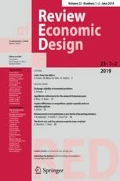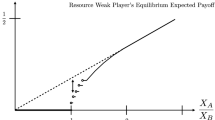Abstract
We study two-stage elimination Tullock contests. In the first stage all the players compete against each other; then some advance to the second stage while the others are removed. The finalists compete against each other in the second stage, and one of them wins the prize. To maximize the expected total effort, the designer can give a head start to the winner of the first stage when he competes against the other finalists in the second stage. We show that the optimal head start, independent of the number of finalists, always increases the players’ expected total effort. We also show how the number of players and finalists affect the value of the optimal head start.
Similar content being viewed by others
Notes
A number of studies provided axiomatic justification for the Tullock contest (see, for example, Skaperdas 1996; Clark and Riis 1998). Baye and Hoppe (2003) have identified conditions under which a variety of rent-seeking contests, innovation tournaments, and patent-race games are strategically equivalent to the Tullock contest.
The incentive for the players who advance from the first stage to the second could also be endogenous since a win in the first stage may give an advantage in the second one.
It can be shown that it is optimal to award the entire prize sum (which is equal to 1) to the winner in the second stage instead of splitting the entire prize into two prizes, one for the finalist with the highest effort and the other for the second finalist.
Our results are robust for other forms of the head start. If , for example, we assume that player i’s probability to win the first prize is \(\frac{(y_{i})^{\beta }}{(y_{i})^{\beta }+y_{j}}\) , the results will remain robust.
It can be easily verified that the S.O.C. for this maximization problem is satisfied.
It can be easily shown that the S.O.C. is satisfied for this value of the optimal head start.
References
Amegashie J (1999) The design of rent-seeking competitions: committees, preliminary and final contests. Public Choice 99:63–76
Amegashie J, Cadsby C, Song Y (2007) Competitive burnout: theory and experimental evidence. Games Econ Behav 59:213–239
Baye M, Hoppe H (2003) The strategic equivalence of rent-seeking, innovation, and patent-race games. Games Econ Behav 44(2):217–226
Clark D, Riis C (1996) A multi-winner nested rent-seeking contest. Public Choice 77:437–443
Clark D, Riis C (1998) Contest success functions: an extension. Econ Theory 11:201–204
Dasgupta A, Nti KO (1998) Designing an optimal contest. Eur J Polit Econ 14:587–603
Denter P, Sisak D (2016) Head starts in dynamic tournaments. Econ Lett 149:94–97
Drugov M, Ryvkin D (2017) Biased contests for symmetric players. Games Econ Behav 103:116–144
Epstein G, Mealem Y, Nitzan S (2011) Political culture and discrimination in contests. J Public Econ 1–2:88–93
Franke J, Kanzow C, Leininger W, Schwartz A (2013) Effort maximization in asymmetric contest games with heterogeneous contestants. Econ Theory 52(2):586–630
Fu Q, Lu J (2012) The optimal multi-stage contest. Econ Theory 51(2):351–382
Groh C, Moldovanu B, Sela A, Sunde U (2012) Optimal seedings in elimination tournaments. Econ Theory 49:59–80
Kirkegaard R (2012) Favoritism in contests: head starts and handicaps. Games Econ Behav 76(1):226–248
Konrad K (2002) Investment in the absence of property rights: the role of incumbency advantages. Eur Econ Rev 46(8):563–575
Kovenock D, Roberson B (2009) Is the 50-state strategy optimal? J Theor Polit 21(2):213–236
Lazear E, Rosen S (1981) Rank-order tournaments as optimum labor contracts. J Polit Econ 89(5):841–864
Moldovanu B, Sela A (2006) Contest architecture. J f Econ Theory 126(1):70–97
Nti KO (2004) Maximum efforts in contests with asymmetric valuations. Eur J Polit Econ 20:1059–1066
Segev E, Sela A (2014) Sequential all-pay auctions with head starts. Soc Choice Welf 43(4):893–923
Sheremeta R (2010a) Expenditures and information disclosure in two-stage political contests. J Confl Resolut 54:771–798
Sheremeta R (2010b) Experimental comparison of multi-stage and one-stage contests. Games Econ Behav 68:731–747
Skaperdas S (1996) Contest success functions. Econ Theory 7:283–290
Tsoulouhas T, Knoeber CR, Agrawal A (2007) Contests to become CEO: Incentives, selection and handicaps. Econ Theory 30:195–221
Tullock G (1980) Efficient rent-seeking. In: Buchanan JM, Tollison RD, Tullock G (eds) Toward a theory of rent-seeking society. Texas A&M University Press, College Station
Author information
Authors and Affiliations
Corresponding author
Appendix
Appendix
1.1 Proof of Proposition 1
The F.O.C. of the maximization problem (5) is
By symmetry, we obtain
Thus, the subgame perfect equilibrium strategy in the first stage is
1.2 Proof of Proposition 3
By symmetry, the F.O.C. of the maximization problem (12) yields
Thus, the subgame perfect equilibrium strategy in the first stage is
1.3 Proof of Proposition 4
The F.O.C. of the maximization of the total effort given by (13) is
By some calculations we have
When \(\alpha \) approaches one we obtain that
Since
We obtain,
Therefore, the head start \(\alpha >1\), independent of the number of the finalists k, increases the players’ total effort.
Rights and permissions
About this article
Cite this article
Cohen, N., Maor, G. & Sela, A. Two-stage elimination contests with optimal head starts. Rev Econ Design 22, 177–192 (2018). https://doi.org/10.1007/s10058-018-0216-1
Received:
Accepted:
Published:
Issue Date:
DOI: https://doi.org/10.1007/s10058-018-0216-1




